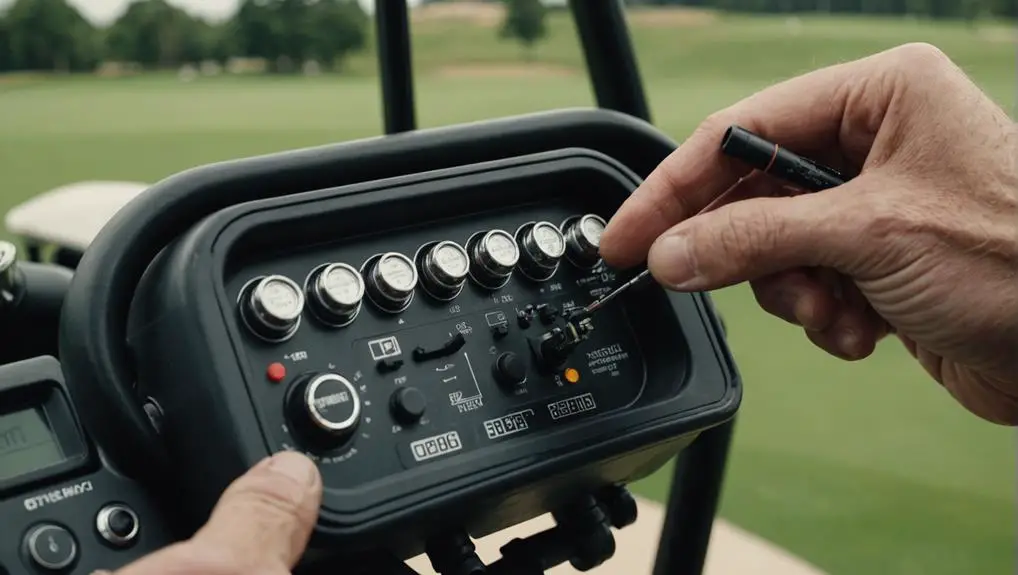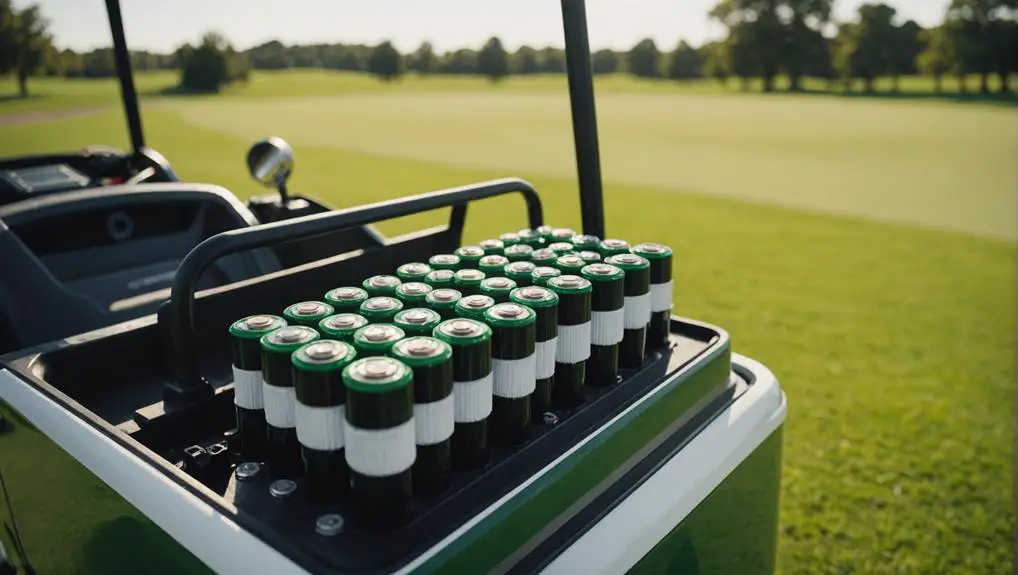You might be surprised to learn that a simple battery check can often be the key to resolving hesitation issues in your electric golf cart. If you've noticed that your cart lags when you hit the accelerator, it's essential to explore some quick fixes that can restore its performance. From inspecting wiring connections to evaluating your throttle sensor, there are several steps you can take that might just do the trick. Curious about what you should tackle first to get back on the course smoothly?
Key Takeaways
- Check battery voltage; ensure each battery reads at least 6.2 volts or 12.4 volts for optimal performance.
- Inspect all wiring connections for corrosion, wear, or loose fittings to ensure proper electrical flow.
- Examine the throttle sensor for secure connections and test its output voltage for smooth operation.
- Clean battery terminals with a baking soda solution to remove corrosion that may hinder performance.
- Verify tire pressure according to the manufacturer's specifications to ensure smooth acceleration and handling.
Check the Battery Voltage
Checking the battery voltage is essential for diagnosing electric golf cart hesitation. Start by turning off the cart and locating the battery compartment. Using a digital multimeter, set it to the DC voltage setting. Connect the red probe to the positive terminal and the black probe to the negative terminal of the first battery. Record the voltage reading.
Ideally, each battery should show a minimum of 6.2 volts for a 6-volt battery or 12.4 volts for a 12-volt battery. Next, repeat this process for all batteries in the series. If you find any batteries below the minimum threshold, they may be weak or failing, contributing to the hesitation.
After checking all batteries, calculate the total voltage. For example, a fully charged 36-volt system should read around 38.2 volts. If your readings consistently show low voltage, you'll need to charge the batteries fully.
Once charged, recheck the voltage to verify they're healthy. If the problem persists after confirming the proper voltage, further investigation may be necessary. Remember, maintaining peak battery health is key to assuring smooth operation of your electric golf cart.
Inspect the Wiring Connections
After verifying your battery voltage is within the proper range, the next step is to inspect the wiring connections. Loose or damaged connections can lead to hesitation during acceleration, so it's vital to address this issue.
Start by visually inspecting all wiring for signs of wear, corrosion, or fraying. Pay particular attention to the following areas:
- Battery terminals: Confirm they're tight and free of corrosion.
- Controller connections: Check for secure and clean connections to the speed controller.
- Motor wires: Look for any signs of damage or loose connections leading to the motor.
Once you've identified any problematic areas, tighten or clean connections as necessary. If you notice any damaged wires, replace them immediately to prevent further issues.
Use a multimeter to test continuity in the wiring, confirming that electricity flows without interruption. It's important to maintain a thorough inspection routine, as consistent monitoring of your golf cart's wiring can help prevent future hesitation problems.
Examine the Throttle Sensor

One critical component to examine when troubleshooting electric golf cart hesitation is the throttle sensor. This sensor measures the position of the accelerator pedal and sends signals to the controller, dictating how much power the motor should receive. If the throttle sensor is malfunctioning, it can lead to inconsistent acceleration and hesitation.
Start by locating the throttle sensor, usually found near the accelerator pedal assembly. Verify the connections are secure and free from corrosion. Next, check for any physical damage to the sensor housing. If you spot cracks or wear, consider replacing the sensor.
Using a multimeter, you can test the sensor's output voltage. With the pedal fully pressed, the voltage should increase smoothly within the designated range specified in your cart's manual. If the readings are erratic or outside the specified range, the sensor may need recalibration or replacement.
After any adjustments or replacements, reconnect everything and take your cart for a test drive. Monitor the acceleration response closely. If hesitation persists, further investigation into other components may be necessary, but a properly functioning throttle sensor is essential for smooth operation.
Test the Motor Controller
Once you've guaranteed the throttle sensor is functioning correctly, the next step is to test the motor controller. This component is essential for controlling the power delivered to the electric motor, and any issues here can lead to hesitation during acceleration.
Start by inspecting the wiring and connections to verify they're secure and free from corrosion.
Next, use a multimeter to check the voltage output from the controller. Here's what to focus on:
- Input Voltage: Confirm the controller receives the correct voltage from the battery.
- Output Voltage: Measure the voltage output when you press the accelerator to see if it fluctuates.
- Error Codes: If your controller has a diagnostic feature, check for any error codes that could indicate a malfunction.
If the voltages are inconsistent or you notice error codes, it's likely that the motor controller is malfunctioning.
In such cases, you may need to replace it or consult a professional. Testing the motor controller is an essential step in diagnosing your golf cart's hesitation issue, guaranteeing a smooth and responsive drive.
Clean the Battery Terminals

Cleaning the battery terminals is an essential step in resolving hesitation issues in your electric golf cart. Corrosion or dirt on the terminals can impede electrical flow, leading to performance problems.
Start by gathering your materials: a wrench, a wire brush, baking soda, water, and a cloth.
First, verify your cart is turned off and unplugged from any power source. Using the wrench, carefully disconnect the negative terminal first, followed by the positive terminal. This prevents any accidental short circuits.
Inspect the terminals for corrosion, which often appears as a white, powdery substance.
To clean them, mix a tablespoon of baking soda with a cup of water. Apply this solution to the terminals and scrub with the wire brush. This will neutralize any acid and remove corrosion.
Rinse the terminals with clean water and dry them thoroughly with the cloth.
Reattach the terminals by connecting the positive terminal first, then the negative. Verify they're tight but not over-tightened.
After cleaning the battery terminals, test drive your golf cart to see if the hesitation issue has improved. Regular maintenance of the terminals will help prolong battery life and enhance performance.
Review the Tire Pressure
After verifying the battery terminals are clean and secure, the next step is to check your tire pressure. Proper tire pressure is essential for peak performance and can directly affect how your electric golf cart accelerates. Low tire pressure increases rolling resistance, leading to hesitation when you try to speed up.
Here's what you need to do:
- Check Manufacturer Specifications: Refer to your cart's manual for the recommended tire pressure, typically measured in PSI (pounds per square inch).
- Use a Tire Pressure Gauge: A reliable gauge will help you measure the current pressure accurately. Make sure to check each tire, as pressure can vary.
- Inflate if Necessary: If you find the pressure is below the recommended level, use an air compressor to inflate the tires to the proper specification.
Maintaining the correct tire pressure not only enhances acceleration but also improves overall handling and tire life.
Regularly checking your tire pressure can prevent issues and guarantee a smooth ride. Make this a part of your routine maintenance to keep your electric golf cart operating at its best.
Frequently Asked Questions
How Can I Tell if My Golf Cart Needs a New Battery?
To determine if your golf cart needs a new battery, check for signs like slow acceleration, a significant drop in speed, or the cart not holding a charge.
Test the battery voltage using a multimeter; if it's below 12.4 volts, it may need replacing.
Also, inspect for corrosion on terminals and any swelling or leakage in the battery case.
If you notice any of these issues, it's time to contemplate a new battery.
What Tools Do I Need for Basic Golf Cart Maintenance?
Have you ever wondered what tools you need for basic golf cart maintenance?
To keep your cart running smoothly, you'll want a few essentials. Grab a socket set for tightening bolts, a multimeter to check electrical connections, and a wrench for battery terminals.
Don't forget screwdrivers for various screws and a tire pressure gauge to monitor tire health.
With these tools, you'll be well-equipped to tackle routine maintenance and guarantee your golf cart stays in top shape.
Is It Safe to Drive a Hesitant Golf Cart?
Driving a hesitant golf cart isn't safe. When you experience hesitation, it can indicate underlying issues that may affect control and responsiveness.
You might struggle to accelerate or stop effectively, increasing the risk of accidents. Before hitting the course, you should address any hesitation by checking batteries, connections, or motor components.
If you're unsure about the problem, it's best to consult a professional to guarantee your safety while driving.
How Often Should I Check the Battery Voltage?
How often should you check your battery voltage? Ideally, you should check it at least once a month.
Regular monitoring helps you catch any potential issues early, ensuring your golf cart runs smoothly.
If you notice any performance dips or inconsistencies, check the voltage more frequently.
Keeping your batteries in top shape not only prolongs their life but also enhances your overall experience while driving.
Can Weather Conditions Affect My Golf Cart's Acceleration?
Yes, weather conditions can definitely affect your golf cart's acceleration.
Cold temperatures can reduce battery efficiency, leading to sluggish performance.
Humidity may cause electrical components to corrode, impacting acceleration as well.
If it's rainy or wet, water can seep into connections, causing resistance.
To maintain peak performance, consider checking your battery and electrical systems regularly, especially during extreme weather conditions, ensuring they're clean and dry for reliable acceleration.
Conclusion
By following these quick fixes, you can transform your hesitant electric golf cart into a smooth, powerful ride that feels like flying down the fairway. Always start with the battery voltage, ensuring it's up to par, and check all connections for potential issues. Don't overlook the throttle sensor and motor controller, as they play vital roles in performance. With these simple steps, you'll have your cart accelerating like a cheetah in no time!